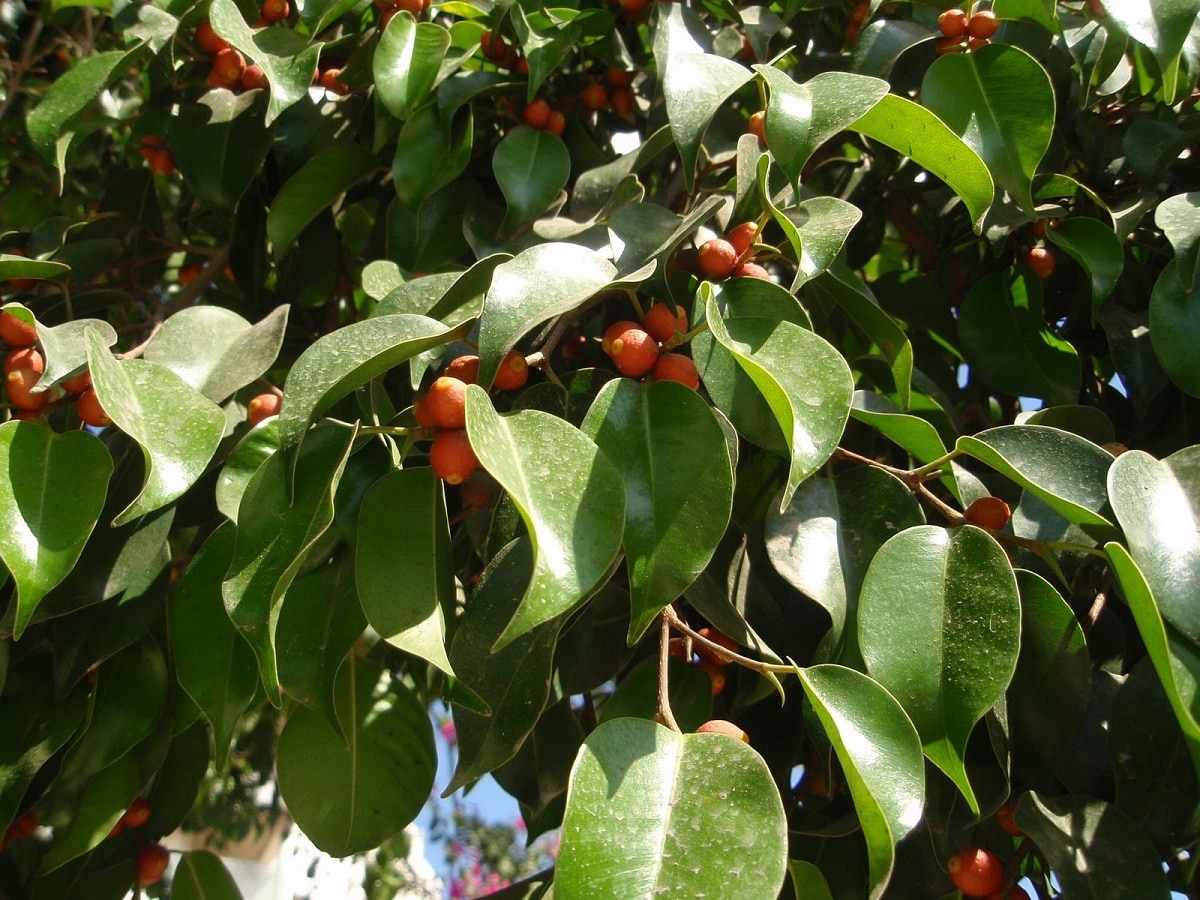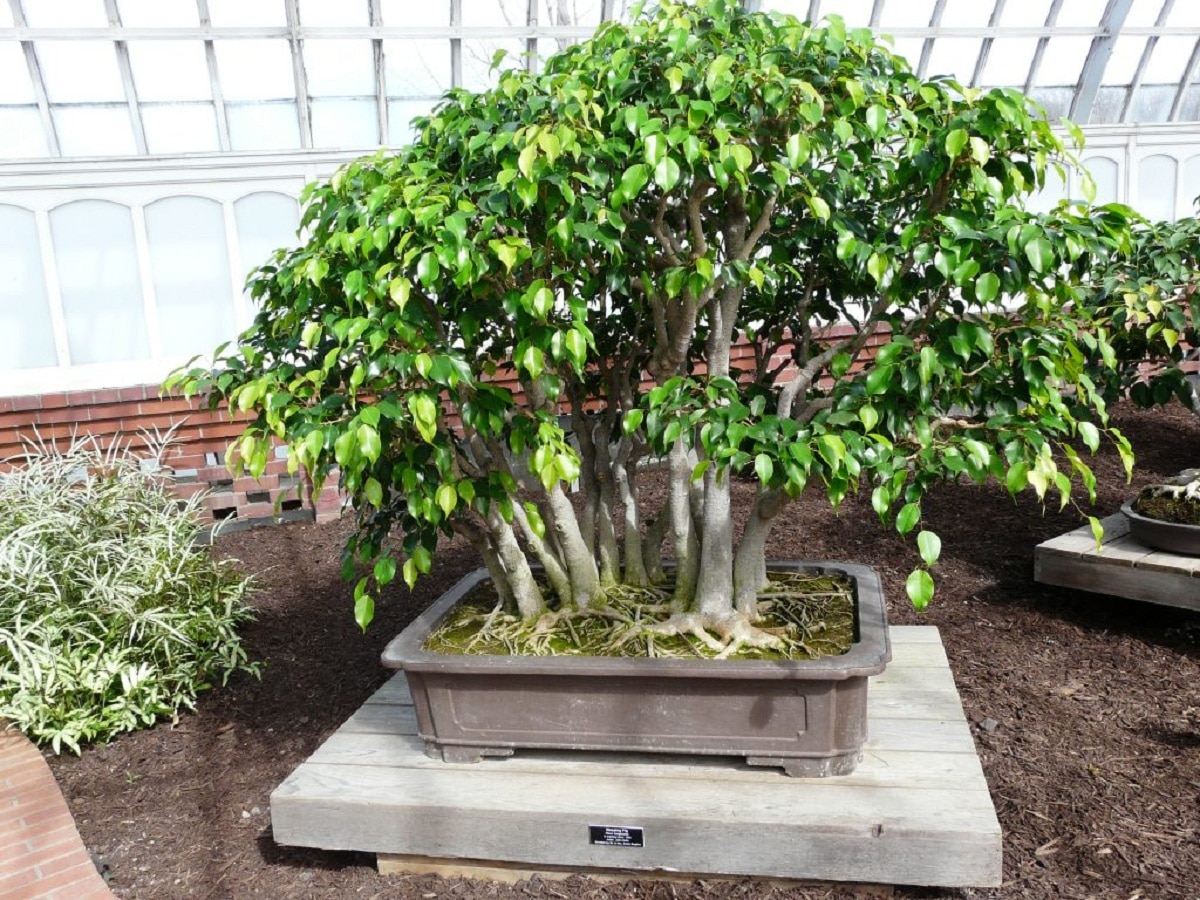
One of the most widely grown plants in homes and indoor gardens in the world is the Ficus benjamina. Above all it is planted in those places that do not have outdoor spaces, but that there is enough space to have plants and shrubs that give a very special touch to the decoration. One of the reasons why this plant is planted indoors is because they do not tolerate high temperatures very well, and low humidity.
In some cases, I have found that many people have them in their outdoor garden or on their terrace, and although they can withstand these negative characteristics such as heat and low humidity, it is best to grow them in an environment that is favorable for them to do so. can develop and grow in the best way. It is for this reason that This time we bring you the best care that you should take into account when growing a Ficus benjamina.
Features Ficus benjamina

Image - Wikimedia / Forest and Kim Starr
El Ficus benjamina It is a shrub or arboreal plant widely cultivated as an ornamental that belongs to the Moraceae family. It is a species native to Southeast Asia and the South Australian region; in particular we will find it in India, Jaba and Bali. As well as from the north and south of Australia, Bhutan, Cambodia, China, the Philippines, Laos, Malaysia, Nepal, New Guinea, Thailand, Vietnam and the Pacific Islands.
It is a choke type plant. In its juvenile period it grows on another plant in the form of a climber, emitting aerial roots. Plants adhere to the ground from these roots, build fortifications, drown plants that have climbed, and stand tall.
The foliage is made up of leathery leaves, bright green in color, which have different shades and shapes, depending on the variety. It has thin and mobile branches and fruits as small as figs, which are the food of several birds from which it originated. In winter, it stops developing and in spring it begins to grow new branches and buds. Leaves that are newer show a lighter, bright green color.
It is a common plant for hedges in potted plants in parks, gardens or houses, offices and places of entertainment. At the moment, its use is restricted in some cities due to the damage that its root system causes to the infrastructure.
How do you take care of the Ficus benjamina?
It is important that you keep in mind that you should not water the plant more than twice a week during the summer, but during the winter you should do it every 10 days or so. Remember to be very careful with watering, because if you over water, the plant could spoil. During the establishment of the plant, the waterings must be constant; This plant is fast growing and perspires a lot, so it requires high humidity. Lack of irrigation causes yellowing and defoliation of the plant. Although it can be easily recovered, it loses its ornamental character.
In the first years it can be kept in a home pot, but due to its rapid development we will not be able to keep it there for life. We will have a replacement container or a planting container, absolutely in the soil of our orchard or garden. If we can root it regularly (we always can and we cannot overdo it), this process may be delayed, but it is not recommended because we somehow limit the potential of this tree to grow in large spaces.
El ficus benjamina it is a tree that can tolerate high temperatures and relatively dry areas. It has a unique way of adapting to the climate, that is, the density of its leaves changes with light and time. In areas exposed to direct sunlight, it tends to produce denser leaves, while in shady areas, the leaves tend to drop downward, hanging branches.
Where to locate Ficus benjamina?
First of all it is important that when sowing this plant, be sure to put it in a place with a lot of light. As for the temperature, it is best that it is between 13 and 24 degrees Celsius, either during the summer or during the winter. Although this plant can withstand a few degrees more or a few degrees less, it is best that they always be in that range.
Plagues and diseases
The Ficus benjamina is a strong plant resistant to various diseases, although can be attacked by certain pests, like aphidsAphis) and mites such as Red spider (Tetranychus urticae); in hot climates, white flies (dactylopius coccus) Y trips (Frankliniella occidentalis).
Among the most common diseases we find those that produce prominent spots on the leaves are caused by Cercospora, Corynespora and Gloesporium. And the appearance of root fungi (such as Fusarium and Phytophthora) caused by the high humidity of the substrate.
Pruning
It can be pruned as needed. However, pruning during the dormant season (winter) is mandatory to keep the structure strong. The winter that has stopped growth is used to increase the strength of the structure. Dead and diseased branches should be cut and removed from inside the tree.
Bonsai care Ficus benjamina

We can also have this species in bonsai mode, although it requires some more complex care:
- You have to place the bonsai in an area with lots of natural light but no direct sunlight.
- Recommended water it every time the substrate has dried. Watering as a mist every day or every other day to maintain a high humidity index can also be beneficial, especially if you want the tree to have aerial roots.
- In winter, the ficus consumes less water, but remains active when your location heats up.
- Subscribing must be done once a week and every two weeks in summer and once a month in winter. You can use liquid fertilizer or organic compost in spheres.
- The ficus must be transplanted every two years in spring. Use a mulch-based substrate with peat and coarse sand.
I hope that with this information you can learn more about Ficus benjamina and its care.

